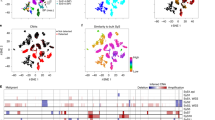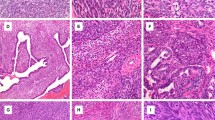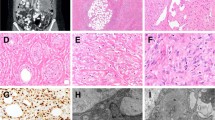Abstract
Synovial sarcomas are aggressive soft-tissue malignancies that express chromosomal translocation-generated fusion genes, SS18-SSX1 or SS18-SSX2 in most cases. Here, we report a mouse sarcoma model expressing SS18-SSX1, complementing our prior model expressing SS18-SSX2. Exome sequencing identified no recurrent secondary mutations in tumors of either genotype. Most of the few mutations identified in single tumors were present in genes that were minimally or not expressed in any of the tumors. Chromosome 6, either entirely or around the fusion gene expression locus, demonstrated a copy number gain in a majority of tumors of both genotypes. Thus, by fusion oncogene coding sequence alone, SS18-SSX1 and SS18-SSX2 can each drive comparable synovial sarcomagenesis, independent from other genetic drivers. SS18-SSX1 and SS18-SSX2 tumor transcriptomes demonstrated very few consistent differences overall. In direct tumorigenesis comparisons, SS18-SSX2 was slightly more sarcomagenic than SS18-SSX1, but equivalent in its generation of biphasic histologic features. Meta-analysis of human synovial sarcoma patient series identified two tumor–gentoype–phenotype correlations that were not modeled by the mice, namely a scarcity of male hosts and biphasic histologic features among SS18-SSX2 tumors. Re-analysis of human SS18-SSX1 and SS18-SSX2 tumor transcriptomes demonstrated very few consistent differences, but highlighted increased native SSX2 expression in SS18-SSX1 tumors. This suggests that the translocated locus may drive genotype–phenotype differences more than the coding sequence of the fusion gene created. Two possible roles for native SSX2 in synovial sarcomagenesis are explored. Thus, even specific partial failures of mouse genetic modeling can be instructive to human tumor biology.
This is a preview of subscription content, access via your institution
Access options
Subscribe to this journal
Receive 50 print issues and online access
$259.00 per year
only $5.18 per issue
Buy this article
- Purchase on Springer Link
- Instant access to full article PDF
Prices may be subject to local taxes which are calculated during checkout







Similar content being viewed by others
References
Herzog CE . Overview of sarcomas in the adolescent and young adult population. J Pediatr Hematol Oncol 2005; 27: 215–218.
Turc-Carel C, Dal Cin P, Limon J, Rao U, Li FP, Corson JM et al. Involvement of chromosome X in primary cytogenetic change in human neoplasia: nonrandom translocation in synovial sarcoma. Proc Natl Acad Sci USA 1987; 84: 1981–1985.
de Leeuw B, Balemans M, Olde Weghuis D, Geurts van Kessel A . Identification of two alternative fusion genes, SYT-SSX1 and SYT-SSX2, in t(X;18)(p11.2;q11.2)-positive synovial sarcomas. Hum Mol Genet 1995; 4: 1097–1099.
Clark J, Rocques PJ, Crew AJ, Gill S, Shipley J, Chan AM et al. Identification of novel genes, SYT and SSX, involved in the t(X;18)(p11.2;q11.2) translocation found in human synovial sarcoma. Nat Genet 1994; 7: 502–508.
Crew AJ, Clark J, Fisher C, Gill S, Grimer R, Chand A et al. Fusion of SYT to two genes, SSX1 and SSX2, encoding proteins with homology to the Kruppel-associated box in human synovial sarcoma. EMBO J 1995; 14: 2333–2340.
Chen YT, Alpen B, Ono T, Gure AO, Scanlan MA, Biggs WH 3rd et al. Identification and characterization of mouse SSX genes: a multigene family on the X chromosome with restricted cancer/testis expression. Genomics 2003; 82: 628–636.
Gure AO, Tureci O, Sahin U, Tsang S, Scanlan MJ, Jager E et al. SSX: a multigene family with several members transcribed in normal testis and human cancer. Int J Cancer 1997; 72: 965–971.
Gure AO, Wei IJ, Old LJ, Chen YT . The SSX gene family: characterization of 9 complete genes. Int J Cancer 2002; 101: 448–453.
Perani M, Ingram CJ, Cooper CS, Garrett MD, Goodwin GH . Conserved SNH domain of the proto-oncoprotein SYT interacts with components of the human chromatin remodelling complexes, while the QPGY repeat domain forms homo-oligomers. Oncogene 2003; 22: 8156–8167.
Kadoch C, Crabtree GR . Reversible disruption of mSWI/SNF (BAF) complexes by the SS18-SSX oncogenic fusion in synovial sarcoma. Cell 2013; 153: 71–85.
Su L, Sampaio AV, Jones KB, Pacheco M, Goytain A, Lin S et al. Deconstruction of the SS18-SSX fusion oncoprotein complex: insights into disease etiology and therapeutics. Cancer cell 2012; 21: 333–347.
Sandberg AA, Bridge JA . Updates on the cytogenetics and molecular genetics of bone and soft tissue tumors. Synovial sarcoma. Cancer Genet Cytogenet 2002; 133: 1–23.
Barretina J, Taylor BS, Banerji S, Ramos AH, Lagos-Quintana M, Decarolis PL et al. Subtype-specific genomic alterations define new targets for soft-tissue sarcoma therapy. Nat Genet 2010; 42: 715–721.
Przybyl J, Sciot R, Wozniak A, Schoffski P, Vanspauwen V, Samson I et al. Metastatic potential is determined early in synovial sarcoma development and reflected by tumor molecular features. Int J Biochem Cell Biol 2014; 53: 505–513.
Joseph CG, Hwang H, Jiao Y, Wood LD, Kinde I, Wu J et al. Exomic analysis of myxoid liposarcomas, synovial sarcomas, and osteosarcomas. Genes Chromosomes Cancer 2014; 53: 15–24.
Haldar M, Hancock JD, Coffin CM, Lessnick SL, Capecchi MR . A conditional mouse model of synovial sarcoma: insights into a myogenic origin. Cancer Cell 2007; 11: 375–388.
Haldar M, Hedberg ML, Hockin MF, Capecchi MR . A CreER-based random induction strategy for modeling translocation-associated sarcomas in mice. Cancer Res 2009; 69: 3657–3664.
Goodwin ML, Jin H, Straessler K, Smith-Fry K, Zhu JF, Monument MJ et al. Modeling alveolar soft part sarcomagenesis in the mouse: a role for lactate in the tumor microenvironment. Cancer Cell 2014; 26: 851–862.
Straessler KM, Jones KB, Hu H, Jin H, van de Rijn M, Capecchi MR . Modeling clear cell sarcomagenesis in the mouse: cell of origin differentiation state impacts tumor characteristics. Cancer Cell 2013; 23: 215–227.
Amary MF, Berisha F, Bernardi Fdel C, Herbert A, James M, Reis-Filho JS et al. Detection of SS18-SSX fusion transcripts in formalin-fixed paraffin-embedded neoplasms: analysis of conventional RT-PCR, qRT-PCR and dual color FISH as diagnostic tools for synovial sarcoma. Mod Pathol 2007; 20: 482–496.
Guillou L, Benhattar J, Bonichon F, Gallagher G, Terrier P, Stauffer E et al. Histologic grade, but not SYT-SSX fusion type, is an important prognostic factor in patients with synovial sarcoma: a multicenter, retrospective analysis. J Clin Oncol 2004; 22: 4040–4050.
Ladanyi M, Antonescu CR, Leung DH, Woodruff JM, Kawai A, Healey JH et al. Impact of SYT-SSX fusion type on the clinical behavior of synovial sarcoma: a multi-institutional retrospective study of 243 patients. Cancer Res 2002; 62: 135–140.
Mezzelani A, Mariani L, Tamborini E, Agus V, Riva C, Lo Vullo S et al. SYT-SSX fusion genes and prognosis in synovial sarcoma. Br J Cancer 2001; 85: 1535–1539.
Takenaka S, Ueda T, Naka N, Araki N, Hashimoto N, Myoui A et al. Prognostic implication of SYT-SSX fusion type in synovial sarcoma: a multi-institutional retrospective analysis in Japan. Oncol Rep 2008; 19: 467–476.
Kubo T, Shimose S, Fujimori J, Furuta T, Ochi M . Prognostic value of SS18-SSX fusion type in synovial sarcoma; systematic review and meta-analysis. SpringerPlus 2015; 4: 375.
Barrott JJ, Illum BE, Jin H, Zhu JF, Mosbruger T, Monument MJ et al. beta-catenin stabilization enhances SS18-SSX2-driven synovial sarcomagenesis and blocks the mesenchymal to epithelial transition. Oncotarget 2015; 6: 22758–22766.
Kawai A, Woodruff J, Healey JH, Brennan MF, Antonescu CR, Ladanyi M . SYT-SSX gene fusion as a determinant of morphology and prognosis in synovial sarcoma. N Engl J Med 1998; 338: 153–160.
Francis JC, Melchor L, Campbell J, Kendrick H, Wei W, Armisen-Garrido J et al. Whole-exome DNA sequence analysis of Brca2- and Trp53-deficient mouse mammary gland tumours. J Pathol 2015; 236: 186–200.
Kim SK, Nasu A, Komori J, Shimizu T, Matsumoto Y, Minaki Y et al. A model of liver carcinogenesis originating from hepatic progenitor cells with accumulation of genetic alterations. Int J Cancer 2014; 134: 1067–1076.
McFadden DG, Papagiannakopoulos T, Taylor-Weiner A, Stewart C, Carter SL, Cibulskis K et al. Genetic and clonal dissection of murine small cell lung carcinoma progression by genome sequencing. Cell 2014; 156: 1298–1311.
Varela I, Klijn C, Stephens PJ, Mudie LJ, Stebbings L, Galappaththige D et al. Somatic structural rearrangements in genetically engineered mouse mammary tumors. Genome Biol 2010; 11: R100.
Wartman LD, Larson DE, Xiang Z, Ding L, Chen K, Lin L et al. Sequencing a mouse acute promyelocytic leukemia genome reveals genetic events relevant for disease progression. J Clin Invest 2011; 121: 1445–1455.
Westcott PM, Halliwill KD, To MD, Rashid M, Rust AG, Keane TM et al. The mutational landscapes of genetic and chemical models of Kras-driven lung cancer. Nature 2015; 517: 489–492.
Yuan W, Stawiski E, Janakiraman V, Chan E, Durinck S, Edgar KA et al. Conditional activation of Pik3ca(H1047R) in a knock-in mouse model promotes mammary tumorigenesis and emergence of mutations. Oncogene 2013; 32: 318–326.
Le Roy H, Ricoul M, Ogata H, Apiou F, Dutrillaux B . Chromosome anomalies in mammary carcinoma from transgenic WAPRAS mice: compression with human data. Genes Chromosomes Cancer 1993; 6: 156–160.
Ogawa K, Osanai M, Obata M, Ishizaki K, Kamiya K . Gain of chromosomes 15 and 19 is frequent in both mouse hepatocellular carcinoma cell lines and primary tumors, but loss of chromosomes 4 and 12 is detected only in the cell lines. Carcinogenesis 1999; 20: 2083–2088.
Carrel L, Willard HF . X-inactivation profile reveals extensive variability in X-linked gene expression in females. Nature 2005; 434: 400–404.
Chen L, Zhou WB, Zhao Y, Liu XA, Ding Q, Zha XM et al. Cancer/testis antigen SSX2 enhances invasiveness in MCF-7 cells by repressing ERalpha signaling. Int J Oncol 2012; 40: 1986–1994.
D'Arcy P, Maruwge W, Wolahan B, Ma L, Brodin B . Oncogenic functions of the cancer-testis antigen SSX on the proliferation, survival, and signaling pathways of cancer cells. PLoS One 2014; 9: e95136.
de Bruijn DR, dos Santos NR, Kater-Baats E, Thijssen J, van den Berk L, Stap J et al. The cancer-related protein SSX2 interacts with the human homologue of a Ras-like GTPase interactor, RAB3IP, and a novel nuclear protein, SSX2IP. Genes Chromosomes Cancer 2002; 34: 285–298.
Breslin A, Denniss FA, Guinn BA SSX2IP: an emerging role in cancerBiochem Biophys Res Commun 2007; 363: 462–465.
Hori A, Peddie CJ, Collinson LM, Toda T . Centriolar satellite- and hMsd1/SSX2IP-dependent microtubule anchoring is critical for centriole assembly. Mol Biol Cell 2015; 26: 2005–2019.
Hur K, Cejas P, Feliu J, Moreno-Rubio J, Burgos E, Boland CR et al. Hypomethylation of long interspersed nuclear element-1 (LINE-1) leads to activation of proto-oncogenes in human colorectal cancer metastasis. Gut 2014; 63: 635–646.
Badea TC, Wang Y, Nathans J . A noninvasive genetic/pharmacologic strategy for visualizing cell morphology and clonal relationships in the mouse. J Neurosci 2003; 23: 2314–2322.
Tang SH, Silva FJ, Tsark WM, Mann JR . A Cre/loxP-deleter transgenic line in mouse strain 129S1/SvImJ. Genesis 2002; 32: 199–202.
Begueret H, Galateau-Salle F, Guillou L, Chetaille B, Brambilla E, Vignaud JM et al. Primary intrathoracic synovial sarcoma: a clinicopathologic study of 40 t(X;18)-positive cases from the French Sarcoma Group and the Mesopath Group. Am J Surg Pathol 2005; 29: 339–346.
Ren T, Lu Q, Guo W, Lou Z, Peng X, Jiao G et al. The clinical implication of SS18-SSX fusion gene in synovial sarcoma. Br J Cancer 2013; 109: 2279–2285.
Sun Y, Sun B, Wang J, Cai W, Zhao X, Zhang S et al. Prognostic implication of SYT-SSX fusion type and clinicopathological parameters for tumor-related death, recurrence, and metastasis in synovial sarcoma. Cancer Sci 2009; 100: 1018–1025.
Nakayama R, Mitani S, Nakagawa T, Hasegawa T, Kawai A, Morioka H et al. Gene expression profiling of synovial sarcoma: distinct signature of poorly differentiated type. Am J Surg Pathol 2010; 34: 1599–1607.
Kokovic I, Bracko M, Golouh R, Ligtenberg M, van Krieken HJ, Hudler P et al. Are there geographical differences in the frequency of SYT-SSX1 and SYT-SSX2 chimeric transcripts in synovial sarcoma? Cancer Detect Prev 2004; 28: 294–301.
Wei Y, Wang J, Zhu X, Shi D, Hisaoka M, Hashimoto H . Detection of SYT-SSX fusion transcripts in paraffin-embedded tissues of synovial sarcoma by reverse transcription-polymerase chain reaction. Chin Med J (Engl) 2002; 115: 1043–1047.
Bijwaard KE, Fetsch JF, Przygodzki R, Taubenberger JK, Lichy JH . Detection of SYT-SSX fusion transcripts in archival synovial sarcomas by real-time reverse transcriptase-polymerase chain reaction. J Mol Diagn 2002; 4: 59–64.
Fernebro J, Francis P, Eden P, Borg A, Panagopoulos I, Mertens F et al. Gene expression profiles relate to SS18/SSX fusion type in synovial sarcoma. Int J Cancer 2006; 118: 1165–1172.
Inagaki H, Nagasaka T, Otsuka T, Sugiura E, Nakashima N, Eimoto T . Association of SYT-SSX fusion types with proliferative activity and prognosis in synovial sarcoma. Mod Pathol 2000; 13: 482–488.
Xu Z, Yang T, Wu B, Zhong H, Yang Z, Zhou B et al. [Detection and analysis of SYT-SSX fusion gene in synovial sarcoma]. Zhonghua Bing Li Xue Za Zhi 2001; 30: 431–433.
Billings SD, Walsh SV, Fisher C, Nusrat A, Weiss SW, Folpe AL . Aberrant expression of tight junction-related proteins ZO-1, claudin-1 and occludin in synovial sarcoma: an immunohistochemical study with ultrastructural correlation. Mod Pathol 2004; 17: 141–149.
Tvrdik D, Povysil C, Svatosova J, Dundr P . Molecular diagnosis of synovial sarcoma: RT-PCR detection of SYT-SSX1/2 fusion transcripts in paraffin-embedded tissue. Med Sci Monit 2005; 11: MT1–MT7.
Li C, Hung Wong W . Model-based analysis of oligonucleotide arrays: model validation, design issues and standard error application. Genome Biol 2001; 2: RESEARCH0032.
Acknowledgements
We thank Matt Hockin for provision of the TATCre and Marc Ladanyi, Louis Guillo, Jean-Michel Coindre, Fernanda Amary, Alessandro Gronchi, Ira Koković, Satoshi Takenaka and Takafumi Ueda for sharing raw data from their previously published patient series. This work was directly supported by the Paul Nabil Bustany Memorial Fund for Synovial Sarcoma Research and the Damon Runyon Cancer Research Foundation to KBJ, National Cancer Institute/National Institutes of Health (NCI/NIH) grant R01CA180006 to LD and National Human Genome Research Institute/NIH grants U01HG006517 to LD and U54HG003079 to RKW. KBJ received additional career development support from NCI/NIH K08CA138764. This work was also partly supported by P30CA042014 from the National Cancer Institute and the Huntsman Cancer Foundation.
Author information
Authors and Affiliations
Corresponding author
Ethics declarations
Competing interests
The authors declare no conflict of interest.
Additional information
Supplementary Information accompanies this paper on the Oncogene website
Supplementary information
Rights and permissions
About this article
Cite this article
Jones, K., Barrott, J., Xie, M. et al. The impact of chromosomal translocation locus and fusion oncogene coding sequence in synovial sarcomagenesis. Oncogene 35, 5021–5032 (2016). https://doi.org/10.1038/onc.2016.38
Received:
Revised:
Accepted:
Published:
Issue Date:
DOI: https://doi.org/10.1038/onc.2016.38
This article is cited by
-
Upregulation of ERK-EGR1-heparanase axis by HDAC inhibitors provides targets for rational therapeutic intervention in synovial sarcoma
Journal of Experimental & Clinical Cancer Research (2021)
-
Establishment and characterization of NCC-SS4-C1: a novel patient-derived cell line of synovial sarcoma
Human Cell (2021)
-
Establishment and characterization of NCC-SS3-C1: a novel patient-derived cell line of synovial sarcoma
Human Cell (2020)
-
Mut2Vec: distributed representation of cancerous mutations
BMC Medical Genomics (2018)
-
The Impact of Microenvironment on the Synovial Sarcoma Transcriptome
Cancer Microenvironment (2017)



